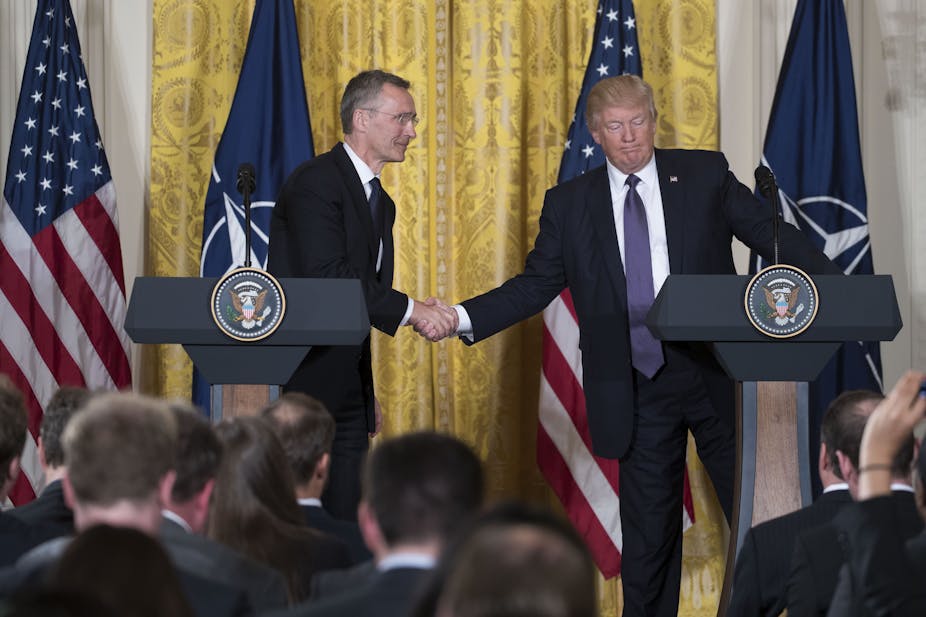So far, 2017 has been a good year for NATO. Donald Trump, who infamously wrote off the alliance as “obsolete” during his election campaign, reversed gear in April, praising it as a “bulwark of international peace and security”.
The new French president, Emmanuel Macron, has promised that France will “honour its commitment to alliances”. And the British prime minister, Theresa May, looks set to win a general election on June 8. This will not only keep NATO doubter Jeremy Corbyn out of Downing Street, but will enable her government to make an unabashed bid for leadership of European defence post-Brexit.
That will position NATO as Europe’s principal provider of military security, something that can only benefit the alliance as it continues to hold a firm line against Moscow. When Russia annexed Crimea in 2014, the NATO allies responded with military support for the Baltic States and Poland, Romania and Bulgaria. The US has been an active participant – and the European Reassurance Initiative launched by the Obama administration has so far continued under Trump.
NATO is also advancing its “southern strategy” in the Middle East, deploying aircraft in Turkish airspace to support the anti-IS coalition and running training programmes for the Iraqi armed forces. In February, NATO defence ministers agreed to create a new “Hub for the South” as a “response to threats stemming from the Middle East and North Africa”.
So, is everything now smooth sailing for the alliance? Far from it.
For one thing, it’s not clear whether Trump’s conversion to NATO will last. His scheduled appearance at the NATO leaders’ meeting on May 25 became a source of high anxiety before it even happened; to keep expectations low, the meeting wasn’t even billed as a formal summit. At the US’s insistence, the working agenda was confined to just two issues: counter-terrorism (including Afghanistan) and burden-sharing.
Neither of these are exactly virgin territory. NATO has been involved in the former for many years. It deployed air patrols to the US immediately after 9/11, and tasked with “countering terrorism at sea”, it has mounted continuous maritime missions in the Mediterranean since 2001.
NATO officials (aided by European foreign ministries) have done a good job in recent weeks of spinning these activities as a coherent package – but even if Trump is persuaded for now, the agenda might still unravel.
Coalition of the unwilling
France, Germany and Italy are unhappy at US proposals to give NATO a greater role in the anti-IS coalition, and there’s little interest outside Washington for expanding NATO’s role in Afghanistan. The military “surge” there currently being considered by the Trump administration seems no more likely to deliver victory against the Taliban than the efforts of George W Bush and Barack Obama. If (or when) things fall short or go wrong again, Trump may well blame the NATO allies for their unwillingness to join the fight.
The US is also unlikely to drop its beef with the problems of burden-sharing. The secretary general reported in March that while 16 NATO allies had seen real increases in overall defence spending in 2016, only five – the US, Estonia, Greece, the UK and Poland – were meeting NATO’s defence spending target of 2% of GDP. Turkey, Romania, Latvia and Lithuania are expected to hit that target in 2018 or 2019, but Germany, Italy and Canada – three of NATO’s biggest hitters – have shown little enthusiasm to do the same. France, Macron has suggested, will not meet the mark until 2025 at the earliest. The Trump administration has promoted the idea of national plans committing the allies to interim targets, but these are just as likely to highlight the problem of underspend as solve it.

Worst of all, lurking behind all of this are two issues the latest summit’s agenda does not address. First, major problems are brewing in the western Balkans: incipient violence in Kosovo, Macedonia and Montenegro could soon drag NATO back into the serious business of Balkan conflict management.
Second, and rather less hypothetically, NATO has a major problem in the shape of an increasingly authoritarian Turkey. For all its lofty democratic language, NATO has long been soft on its members’ political shortcomings, and Trump is not the right American president to make an issue of democratic compliance. What matters more is the alliance’s effectiveness and its members’ solidarity.
President Erdoğan’s purge of the Turkish military after the failed coup of July 2016 degraded the work of NATO Allied Command Operations, in which many senior Turks served. Turkey’s emerging understanding with Russia and Iran over Syria, meanwhile, puts it at odds with the US and its NATO allies, and so complicates NATO’s southern strategy.
NATO may well ride out Trump’s visit to Brussels without public controversy – but behind the scenes, the problems continue to mount.

